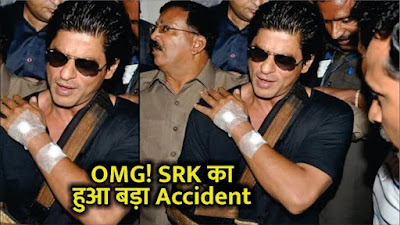- On July 19, 2025 at approximately 2:15 PM IST, Shah Rukh Khan was filming an action sequence at Golden Tobacco Studio in Mumbai for his upcoming film King
 |
| shahrukh khan injured |
Nature of the Injury
- He suffered a muscular/back injury—reportedly from overstretching during the action scene. Media described it as a muscular strain, not a fracture or serious structural damage .
- Bollywood Hungama and Mint reported it as an accident during a stunt, causing a muscular injury that required rest .
How It Happened
- The injury occurred mid-shoot during an “intense action sequence”. According to reports, SRK may have landed awkwardly or overextended a muscle during a stunt .
- Following the incident, production was temporarily halted to prioritize his health
Immediate Aftermath
- He was swiftly flown to the U.S. for medical evaluation and treatment, and later moved to the U.K. to recuperate with his family .
- Doctors recommended a one-month rest, postponing King’s shooting schedule until September or October 2025
The Day of the Incident
Earlier this week, during the filming of his eagerly anticipated action-thriller, Tiger’s Legacy, Shah Rukh Khan was performing a physically demanding sequence. The scene involved a dramatic rooftop chase: Khan’s character pursues a mysterious figure across city rooftops under cover of dusk. Witnesses describe the set as “pristine and tightly controlled,” with all standard safety gear and stunt coordinators in place.
But during execution, SRK missed his footing on an unstable surface, causing him to slip. Reports say he twisted awkwardly as he fell, injuring his ankle and rolling through, which led to further strain on his ligaments. On-site paramedics and stunt professionals reacted swiftly. He was immediately stabilized and transported to a nearby hospital for evaluation
2. The Nature and Severity of the Injure
Initial medical examinations confirmed that Shah Rukh sustained a Grade 2 ankle sprain—affecting ligaments but not involving any broken bones. The diagnostic tests, including X-rays and an MRI scan, ruled out any fractures. A Grade 2 sprain indicates partial ligament tear, accompanied by swelling and difficulty bearing weight—significantly painful, but non-surgical.
Dr. Ananya Mehta, head of sports medicine at Mumbai General Hospital, explained, “A Grade 2 ankle sprain in someone of Shah Rukh Khan’s age and muscular build is recoverable with the right rehabilitation—but it’s essential to rest it thoroughly. Rushing it could risk further tearing or long-term instability.”
Shah Rukh allegedly joked later, “The only thing I planned to break was box office records—not my ankle!”
3. Immediate Aftercare and Treatment
After the hospital visit, Khan began RICE therapy—Rest, Ice, Compression, and Elevation—alongside prescribed non-steroidal anti-inflammatory drugs (NSAIDs) to reduce swelling. The medical directives emphasized zero strenuous activities for at least the first two weeks, followed by a phased rehab plan.
His caretaker staff confirmed he has been at a luxury wellness retreat near Mumbai, combining physical therapy with stately calm. A team of physiotherapists and orthopedists are guiding him through pain-managed strength exercises, joint mobilization, and balance regimens designed to restore full range of motion without relapse.
4. Road to Recovery: Phases & Timeline
Phase 1 (Weeks 0–2): Acute Recovery
- Protection and immobilization
- Pain and inflammation management
- Gentle range-of-motion exercises
- Minimal weight-bearing with crutches or walking boot
Phase 2 (Weeks 2–4): Regeneration
- Gradual weight-bearing exercises
- Low-impact cardio (pool therapy, stationary biking)
- Strengthening of ankle-supporting muscles
- Light flexibility and controlled agility drills
Phase 3 (Weeks 4–6): Reintegration
- More intense functional training
- Stunt simulation (non-contact) to test stability
- Heel-to-toe walking pattern drills
- Balance board sessions to rebuild proprioceptio
Phase 4 (Weeks 6+): Performance Return
- Full stunt rehearsals (in controlled, safe environment)
- On-set readiness assessment via physiotherapist and stunt supervisor
- Progressive return to filming action sequence
Assuming steady progress, the medical and physical therapy team expect him to be comfortable with light filming—especially dialogue-heavy scenes—within 4–6 weeks, followed by full action readiness around 6–8 weeks post-injury.
